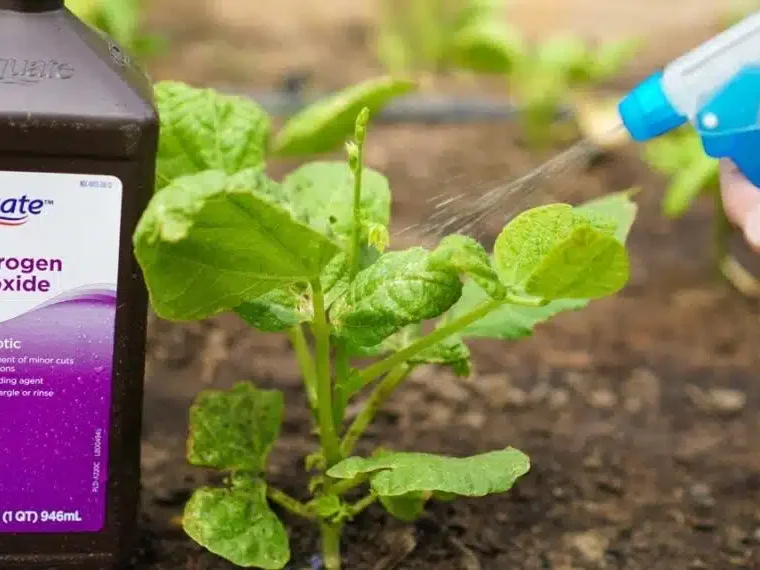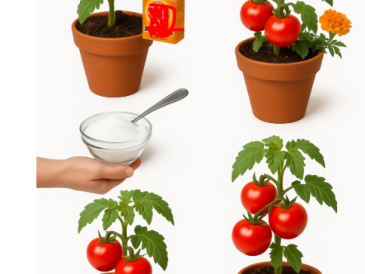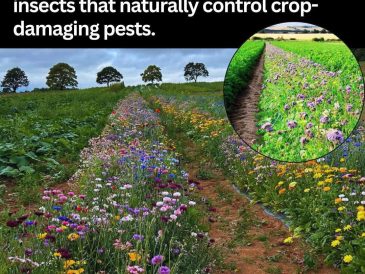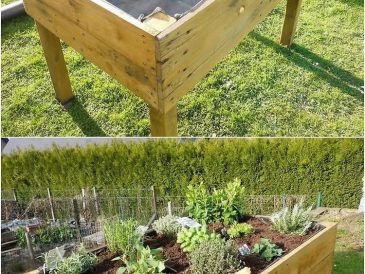When most people think of hydrogen peroxide (H₂O₂), they imagine a brown bottle in the medicine cabinet used to disinfect cuts or clean household surfaces.
But this simple, inexpensive liquid is also one of the most versatile and underrated tools in gardening.
Hydrogen peroxide is essentially water with an extra oxygen atom, and that extra oxygen is what gives it powerful antibacterial, antifungal, and oxidizing properties.
In the garden, it can help with everything from seed germination to root health, pest control, and disease prevention – all without resorting to harsh chemicals.
1. Hydrogen Peroxide Boosts Seed Germination
One of the most effective ways to use hydrogen peroxide is during the seed-starting phase.
The extra oxygen atom helps break down the seed coat, softening it and allowing moisture to penetrate more easily.
How to use: Soak seeds in a solution of 1 teaspoon hydrogen peroxide (3%) per cup of water for 5–10 minutes before planting. Rinse with plain water afterward.
Benefits: Faster germination, reduced risk of fungal infections like damping-off, and stronger seedlings from the start.
Gardeners especially notice improvements with hard-coated seeds such as peas, beans, and sunflowers.
2. Prevents Root Rot and Strengthens Roots
Root rot is a gardener’s nightmare, often caused by overwatering or poor soil drainage.
The roots suffocate from lack of oxygen, creating the perfect environment for harmful fungi.
Hydrogen peroxide helps in two ways:
- Delivers oxygen directly to the root zone.
- Kills harmful pathogens responsible for root rot.
How to use: Mix 1 part 3% hydrogen peroxide with 3 parts water and water plants at the soil level once every 2 weeks.
This keeps the root system aerated and healthy, encouraging vigorous plant growth.
3. Acts as a Natural Fungicide
Powdery mildew, blight, and leaf spot can spread quickly in humid conditions. Instead of resorting to chemical fungicides, hydrogen peroxide offers a natural solution.
How it works: The oxidizing effect kills fungal spores on contact, halting the spread of disease.
How to use: Combine 4 tablespoons hydrogen peroxide (3%) per 1 quart of water in a spray bottle. Mist the affected leaves, especially the undersides.
This works well for roses, cucumbers, squash, and tomatoes, which are especially prone to fungal problems.
4. Helps Control Garden Pests Naturally
Certain pests, including aphids, spider mites, and fungus gnats, dislike hydrogen peroxide. When applied correctly, it can deter or eliminate them without harming your plants.
Soil pests (like fungus gnats): Water the soil with a 1:4 mix of hydrogen peroxide and water to kill larvae.
Leaf pests (like aphids): Spray diluted hydrogen peroxide on infested foliage.
Bonus: It leaves no harmful residue, unlike chemical pesticides.
5. Disinfects Gardening Tools and Pots
Disease often spreads in the garden through dirty tools, containers, and seed trays. Hydrogen peroxide is an excellent disinfectant that kills lingering pathogens.
How to use: Spray tools, pots, or trays with undiluted 3% hydrogen peroxide and let them air dry.
This simple habit can save your entire garden from recurring infections.
6. Promotes Healthy Soil and Microbial Balance
While hydrogen peroxide kills harmful microbes, when diluted properly, it doesn’t destroy all soil life.
Instead, it creates a healthier environment by targeting pathogens while supplying oxygen to beneficial organisms.
How to use: A weak solution of 1 teaspoon per cup of water applied occasionally can freshen compacted soil and improve aeration.
This makes it especially useful in container gardening, where soil can quickly become depleted and stagnant.
7. Keeps Cuttings and Propagations Disease-Free
When propagating plants from cuttings, the open wound is vulnerable to fungal and bacterial infections.
Hydrogen peroxide can sterilize the cutting and encourage root development.
How to use: Dip the base of cuttings in a 3% hydrogen peroxide solution for a few seconds before placing in soil or water.
This method is especially effective for herbs like rosemary, basil, and lavender, as well as houseplants like pothos and philodendrons.
8. Revives Overwatered Plants
Overwatering suffocates roots and leads to yellowing leaves, wilting, and eventual death. Hydrogen peroxide can act as an emergency rescue.
How to use: Mix 1 cup of 3% hydrogen peroxide into 1 gallon of water and water the plant thoroughly.
The extra oxygen helps reoxygenate the root zone, giving stressed plants a chance to recover.
9. Extends the Life of Cut Flowers
If you love bringing fresh flowers indoors, hydrogen peroxide can help keep bouquets fresh longer by killing bacteria in the vase water.
How to use: Add 1 teaspoon hydrogen peroxide and 1 teaspoon sugar per quart of water in a vase.
This simple trick prevents cloudy water and keeps flowers like roses, tulips, and daisies blooming beautifully for several extra days.
10. Cleans Algae and Moss from Garden Surfaces
Algae and moss often grow on patios, garden statues, birdbaths, and greenhouse surfaces. Hydrogen peroxide breaks down algae without toxic chemicals.
How to use: Spray undiluted 3% hydrogen peroxide directly onto algae or moss. Let it sit for 10 minutes, then scrub with a brush and rinse.
This is safer than bleach and won’t harm surrounding plants.
Extra Uses Worth Mentioning
Beyond the top 10, gardeners also use hydrogen peroxide to:
- Sterilize seeds before storage.
- Clean hydroponic systems to prevent algae buildup.
- Treat lawn fungus in patches of brown grass.
It’s an all-around multi-purpose solution for maintaining a clean, healthy, and productive garden.
Safety Tips When Using Hydrogen Peroxide in the Garden
Hydrogen peroxide is safe for gardening when used correctly, but keep these tips in mind:
- Always dilute unless disinfecting tools or surfaces.
- Use 3% household hydrogen peroxide (the common brown-bottle type). Industrial-strength (35%) is too strong for most garden uses unless heavily diluted.
- Avoid spraying during hot, sunny hours as it may scorch leaves. Early morning or evening is best.
- Store properly in a cool, dark place – exposure to light breaks it down into plain water.
Hydrogen peroxide might be one of the most powerful, affordable, and eco-friendly gardening hacks you can add to your toolkit.
From germinating seeds faster to saving overwatered plants, killing pests, and preventing diseases, its benefits are almost endless.
Instead of relying on expensive chemical fertilizers and pesticides, try reaching for that simple brown bottle.
By learning to use hydrogen peroxide wisely, you’ll not only grow healthier plants but also create a safer, more sustainable garden environment.





